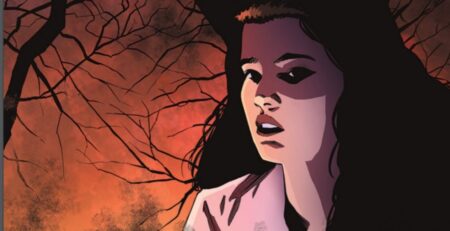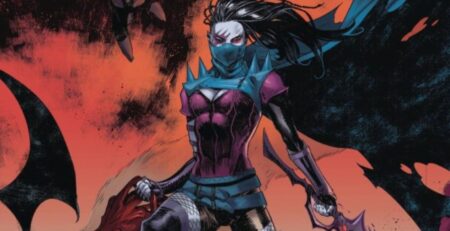
Grendel: Devil’s Odyssey #1 is published by Dark Horse Comics. It comes from the creative team of writer/artist Matt Wagner, colorist Brennan Wagner, and letterer Dave Lanpear. The issue opens with voices speaking in the cold vacuum of space. An artificial intelligence is queried and introduces itself as Sigma-Seven, though it prefers to go by Siggy. In turn, the other voice is referred to as Grendel. Their ship emerges from a wormhole over a planet. After looking it over, the planet is considered to be potentially habitable and Grendel flies the ship toward it. Grendel emerges from the ship as Siggy, shown to be a floating robot head, gives further intel on the planet.
As Grendel looks over the planet, the perspective shifts to a flashback. Planet earth has fallen. The last Grendel-Khan summons Grendel for help. She explains that Grendel must find a suitable planet to rebuild the human race. She also tells him that it must be done as peacefully as possible. Though Grendel does not wish to help, he knows that he is duty-bound to do what he must. With a final bold sacrifice from the Grendel-Khan’s forces, Grendel commandeers a ship filled with clones. Now out among the stars, Grendel must find a suitable planet to give the human race a chance to start anew.
Matt Wagner’s script does a fine job of setting the stage for the intergalactic adventures of his nearly 30-year-old character: Grendel Prime. However, the age of the character and the stories involved is showing. The action and events in the story feel dated. Grendel is a classic stereotype of the grim anti-hero pressed into service. He is gruff, aloof, and confident. This isn’t always a bad thing, but it certainly isn’t original. This leads to the main issue with the script: it doesn’t do anything new or unusual. Every part of this comic feels unoriginal, from the opening dialogue to the “twist” ending.
Wagner’s art, on the other hand, feels a little confused. The character of Grendel looks fresh out of a comic from the 90s. This is fitting because the original iteration was born in this time period. This carries over into the flashback, with everything on the dying Earth fitting the same aesthetic. However, once Grendel is among the stars it is clear that the artwork is designed to mimic the more pulpy 1950s sci-fi aesthetic. Both of these styles separately have their own merits, but together they clash.
Meanwhile, the colors from Brennan Wagner are well done. The disparate locales are each given their own palettes. Earth is filled with reds, space black, and the new planet browns and greens. This helps make the art feel more vibrant, which is a positive. The letters from Dave Lanpear are solid. Thanks to the clear delineation between Grendel and Siggy, it is always clear who is speaking. The light blue background on Siggy’s bubbles provides a clear contrast to Grendel’s more spartan text boxes.
Overall this comic just didn’t hit home for me. The concept is an interesting one, but I’ve already seen it done. It is worth mentioning that this character has been around for decades. The character was also not very appealing to me. The art is nice but seems at war with itself. Though the story did not appeal to me, a long-time fan may find more here than I did. That being said, it is difficult for me to recommend Grendel: Devil’s Odyssey #1 to anyone unfamiliar with the character.
Grendel: Devil’s Odyssey #1 is available in comic stores everywhere right now
Grendel: Devil's Odyssey #1
TL;DR
Overall this comic just didn’t hit home for me. The concept is an interesting one, but I’ve already seen it done. It is worth mentioning that this character has been around for decades. The character was also not very appealing to me. The art is nice but seems at war with itself. Though the story did not appeal to me, a long-time fan may find more here than I did. That being said, it is difficult for me to recommend Grendel: Devil’s Odyssey #1 to anyone unfamiliar with the character.






